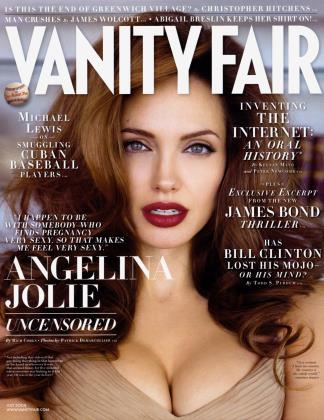Sign In to Your Account
Subscribers have complete access to the archive.
Sign In Not a Subscriber?Join NowCONTRIBUTORS
Michael Lewis
Michael Lewis was surprised by how much trouble a person could cause in Cuba simply by writing about baseball players. In “Commie Ball: A Journey to the End of a Revolution,” page 84, Lewis, a contributor to The New York Tunes Magazine, pursues the story of Los Angeles-based sports agent Gus Dominguez, who was convicted by a U.S. District Court last year of smuggling five Cuban baseball players into the U.S. Lewis followed the story to the source: Cuba’s otherworldly baseball diamonds. “I had snuck in without telling the government I was a journalist, and I was seeing a lot of things that I wouldn’t have had the Cuban authorities known what I was up to. But after I left, my translator was hauled in and told he might face jail time, and I was told by the equivalent of the American ambassador that, once the piece is published, there is no point in me trying to go back.” Lewis’s most recent book is The Blind Side: Evolution of a Game (Norton).
Todd S. Purdum
National editor Todd S. Purdum, now in his third year with Vanity Fair, compares the idea of taming Bill Clinton, whose picaresque post-presidential life he scrutinizes in this month’s issue, to the notion of “controlling the Mississippi River or the Pacific Ocean.” Pointing out that the people he talked to for this story were “overwhelmingly Bill Clinton supporters, friends, aides, current staffers, not opposition-research people or prosecutors,” Purdum believes “the portrait of Clinton that emerges is that his friends are torn and ambivalent about him, because he has not always lived up to his best potential. It’s not that his enemies are attacking him; it’s that his friends are disappointed in him. I think in some ways that’s always been the most poignant side of the Bill Clinton story: that he inevitably ends up disappointing the people who care about him the most and work the hardest for him.”
Cullen Murphy
Editor-at-large Cullen Murphy is comfortable handling just about any genre of magazine article, as evidenced by the three very different pieces he shepherded into publication this month. First there is an investigative story, Todd Purdum’s examination of Bill Clinton’s post-presidency. Then there’s an oral history, Keenan Mayo and Peter Newcomb’s digest of recollections from the pioneers of the Internet. Finally there is an excerpt from a novel—specifically, Sebastian Faulks’s new James Bond book, Devil May Care, commissioned by the estate of Bond creator Ian Fleming. (Murphy also wrote the accompanying sidebar, “The Man with the Golden Pen,” introducing Faulks to VF.’s readers.) Murphy’s most recent book, Are We Rome?, is now out in paperback, from Houghton Mifflin.
CONTINUED ON PAGE 20
CONTINUED FROM PAGE 18
Patrick Demarchelier
While many men and women would be enraptured by the opportunity to photograph actress and United Nations goodwill ambassador Angelina Jolie in the home she shares with Brad Pitt, it was nothing but another two days at the office for Vanity Fair contributing photographer Patrick Demarchelier. Having attained the playful images of the typically private star, he says, “The pictures speak for themselves. Angelina exudes sensuality, and her lack of inhibition made the photo session extremely relaxed.” This September, the French-bom photographer will showcase a career’s worth of work in a retrospective, “Patrick Demarchelier: Images and Fashion,” at the Petit Palais, Musee des Beaux-Arts de la Ville de Paris, in Paris.
Sebastian Faulks
Commemorating the centenary of Ian Fleming’s birth, on May 28,1908, novelist Sebastian Faulks takes up where Fleming left off with the newest Bond novel, Devil May Care. In this month’s issue, we excerpt a scene in which Bond plays a high-stakes tennis match against the villain, Dr. Gomer, whose left hand, hidden by a glove, is shaped like that of a large monkey. (Gomer’s serve is quite unusual.) Noting that Fleming’s daily regimen consisted of writing, snorkeling, martinis, lunch, snorkeling, writing, and more martinis, Faulks told one interviewer, “I followed this routine exactly, apart from the cocktails, the lunch, and the snorkeling.” Devil May Care has just been published by Doubleday.
Peter Newcomb
For senior articles editor Peter Newcomb, compiling V.F.'s oral history of the Internet (“How the Web Was Won,” page 96) with Keenan Mayo was a terrific nostalgia trip. “I was a speechwriter for the C.E.O. of Sony when the Web was just getting started,” he says. “I traveled around to a handful of conferences about the ‘information superhighway’—that’s what they called it back then—listening to people like Barry Diller and A1 Gore explain how this whole thing was going to come together.” Newcomb co-edits V.F.’s New Establishment, our painstakingly concise business-mogul ranking of the leaders of the Information Age, so he found the oral-history form a refreshing change. “I was taught that good editing is the art of compression, but working with these extended quotes was great,” he says. “Still—I can’t believe I’m saying this—it felt as if 15,000 words wasn’t enough.”
Keenan Mayo
Working with Peter Newcomb on Vanity Fair’s oral history of the Internet, editorial associate Keenan Mayo interviewed computer scientists, dot-com billionaires, a former presidential candidate, and many others. While some aspects of the story are well known, Mayo found others eye-opening. “One emphasis in my interviews was the Cold War era of Internet history, when scientists and engineers created the first networks and laid the foundation for today’s Web,” Mayo says. “It was such a small, elite group of young guys—and they were in fact mainly guys—pushing forward these innovations 40 years ago. We realized that this wasn’t just a technology story. It was about a close-knit fraternity.” This is Mayo’s first feature-length article in Vanity Fair; he also contributes to the VF Daily blog at VF.com.
 View Full Issue
View Full Issue






Subscribers have complete access to the archive.
Sign In Not a Subscriber?Join Now